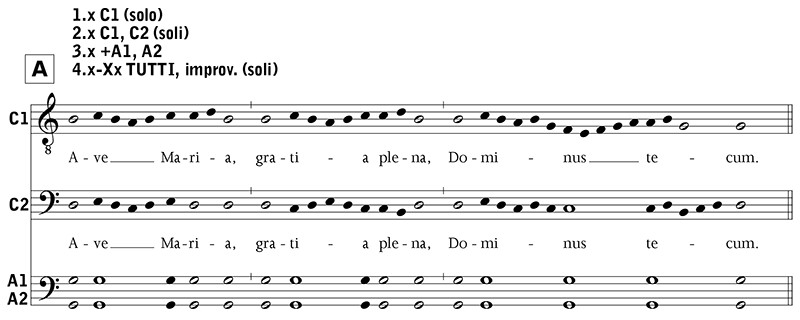
For those of a Catholic persuasion, today is one of the days devoted to Mary in the liturgical calendar, so it’s as good a time as any to feature in my Advent Calendar a setting of Ave Maria by Estonian composer Tõnis Kaumann. A few years ago i explored Kaumann’s Ave maris stella, and described how it functioned in a permutational way, moving between different options to create a simple but ever-changing music. His Ave Maria, composed six years earlier in 2013, takes a similar approach.
The piece has six sections, A to F. Kaumann uses three portions of chant-like melody (having thoroughly checked my Liber Usualis, none of them appears to be a specific Gregorian chant), the first assigned to sections A, C, E and F, the second and third to sections B and D respectively.
Section A (“Ave Maria, gratia plena, Dominus tecum”) is the longest and most elaborate. Melody 1 is repeated multiple times, first by one voice, then two (the second voice singing a parallel / contrary motion version), then four (adding a G drone), after which the whole choir repeats this while soprano and alto soli improvise extensive melismas over the top. This continues for several minutes, occupying most of the work’s 6-minute duration, and grows to become intensely passionate. It’s a fascinating, powerful expansion, ending up a long way from the restrained sobriety of chant.

The remaining sections pass by relatively quickly. Section B (“benedicta tu in mulieribus”) uses Melody 2 twice over a dronal chord. Section C (“et benedictus fructus ventris tui, Jesus”) returns to Melody 1, sung over a slightly lower register chord than previously, then reduced further to just two voices. Section D (“Sancta Maria, Mater Dei, ora pro nobis peccatoribus”) abruptly switches the tonality from G to D, presenting Melody 3 as a strong tutti climax, returning to G at the end. Section E (“nunc et in hora mortis nostrae”) uses most of Melody 1 as an echoing call and response between pairs of voices; the final phrase is saved for Section F, sung as a simple tutti “Amen”.
It’s a superbly effective harnessing of the principles and attitude of conventional chant, spiced up in that remarkable opening section. The cycling repetitions and dronal harmony keep the music grounded, yet i can’t help feeling the intensity of those wildly florid improvisations remains throughout what follows, flaring up somewhat in the ensuing climax, and persisting in the more sedate sections as a kind of implied breathlessness.
This performance of Ave Maria was given by Vox Clamantis conducted by Jaan-Eik Tulve.
Text
Ave Maria, gratia plena, Dominus tecum;
benedicta tu in mulieribus,
et benedictus fructus ventris tui, Jesus.
Sancta Maria, Mater Dei,
ora pro nobis peccatoribus,
nunc et in hora mortis nostrae. Amen.
Hail Mary, full of grace, the Lord is with thee;
blessed art thou among women,
and blessed is the fruit of thy womb, Jesus.
Holy Mary, Mother of God,
pray for us sinners,
now and at the hour of our death. Amen.
Programme note
Ave Maria is unique among my compositions, being the only one I first recorded while singing it myself and then transribed. This might just as well be one of my most performed pieces, because it fits well with the repertoire of Vox Clamantis and is therefore often in use.
—Tõnis Kaumann

I absolutely love this. So amazingly beautiful.